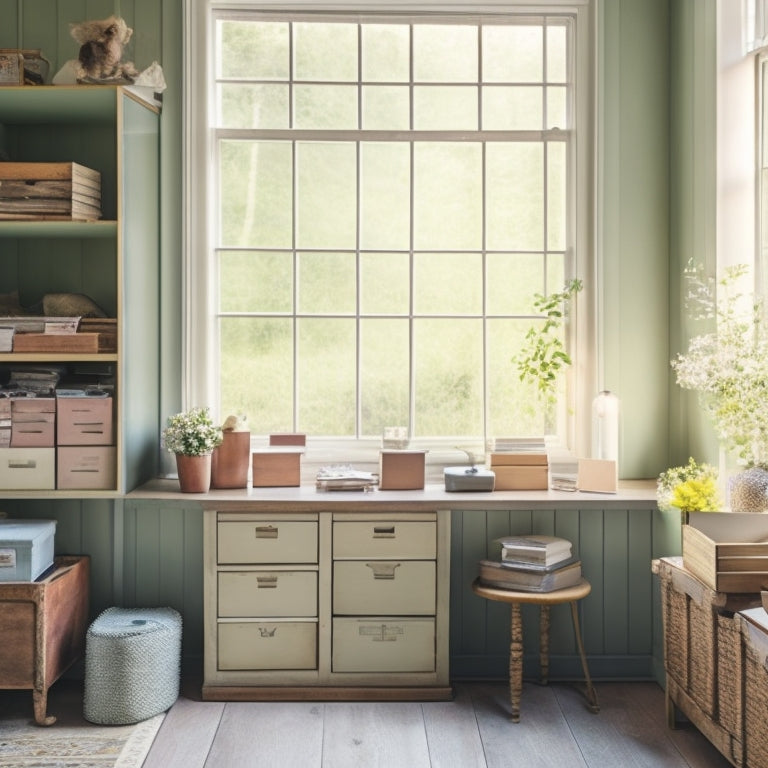
Organizing Your Archive With Archival Storage Boxes
Share
Organizing your archive with archival storage boxes is essential for preserving your important documents and memorabilia. Start by selecting acid-free and durable materials to prevent degradation over time. Measure your items accurately to choose the right box size, ensuring a proper fit and optimizing space. Consider eco-friendly options, like recyclable archival boxes, to protect both your items and the environment. Maintain proper climate control by keeping your boxes at a consistent temperature and humidity level. This methodical approach safeguards your collection's longevity, and you'll uncover more strategies to enhance your archival organization shortly.
What You Need to Know
- Choose acid-free and durable materials for archival storage boxes to prevent document deterioration and ensure long-term protection.
- Measure items accurately to select appropriately sized boxes, preventing damage and optimizing organization.
- Maintain proper climate control with temperatures between 65°F and 70°F and humidity levels between 30% and 50% to safeguard documents.
- Consider eco-friendly options like recycled or biodegradable archival boxes to responsibly preserve your items while benefiting the environment.
- Invest in high-quality archival boxes with reinforced seams and moisture-resistant features for enhanced durability and protection against spills.
Cost-Effective Preservation Solution
When considering archival storage boxes, you'll find a range of affordable material options that suit your budget.
Using optimal storage conditions can further enhance the longevity of your items, guaranteeing they remain in pristine condition.
These choices not only save you money upfront but also contribute to long-term cost benefits by protecting your items from damage.
Investing wisely in these solutions guarantees that your precious documents and memorabilia remain preserved for years to come.
Affordable Material Options
Although high-quality archival storage materials can be expensive, there are several affordable options that provide effective preservation without breaking the bank. You can find budget-friendly alternatives that maintain the integrity of your documents and artifacts.
Consider using acid-free cardboard boxes, which aren't only economical but also offer excellent protection against environmental damage.
When selecting materials, look for versatile design options. Many manufacturers offer customizable boxes that cater to various sizes and shapes, making it easy to fit your unique items. You can also choose from a range of colors and finishes, allowing you to create an organized and aesthetically pleasing archive.
Another cost-effective solution is using plastic storage bins that are acid-free. These bins are durable and can withstand wear and tear, ensuring your collections remain safe.
If you're concerned about moisture, opt for bins with airtight seals.
Long-Term Cost Benefits
Investing in high-quality archival storage solutions often pays off in the long run, as they considerably reduce the risk of damage to your precious items. When you take the time to evaluate budget planning, you'll quickly realize that these boxes aren't just an expense; they're a cost-effective preservation solution that translates to long-term savings.
Here's a simple breakdown of how archival storage compares to other options:
| Storage Type | Initial Cost | Risk of Damage | Long-Term Value |
|---|---|---|---|
| Archival Storage Boxes | Moderate | Low | High |
| Plastic Bins | Low | Moderate | Moderate |
| Cardboard Boxes | Low | High | Low |
| Old Suitcases | Moderate | High | Low |
Enhanced Document Longevity
To guarantee your documents last, focus on the quality of materials used in your archival storage boxes.
Choosing acid-free and lignin-free options greatly reduces degradation over time. Additionally, consider using gentle care products specifically designed for preserving delicate items.
Maintaining proper climate control in storage areas prevents humidity and temperature fluctuations that can harm your documents.
Material Quality Matters
When it comes to preserving important documents, the choice of materials for archival storage boxes can considerably impact their longevity. You want to guarantee that your documents remain intact and free from deterioration over time. Opting for high-quality materials is vital. Acid-free, lignin-free cardboard is a must, as these components can cause yellowing and degradation in your precious papers.
Additionally, take into account the thickness of the box. Thicker materials offer greater resistance to wear and tear, enhancing material durability. Look for boxes that meet archival standards, confirming they're designed specifically for long-term storage.
Another factor to take into account is the presence of protective features, such as moisture barriers. These can help guard against environmental fluctuations, further preserving your documents. If you're serious about safeguarding your archives, investing in boxes that offer both durability and the right protective qualities is fundamental.
In a world where our memories and important documents hold the key to our freedom, don't compromise on material quality. By selecting the right archival storage boxes, you're taking a significant step toward guaranteeing the longevity of your priceless records.
Proper Climate Control
How can you guarantee that your archival documents remain in pristine condition? The answer lies in proper climate control. Start by ensuring effective temperature regulation in your storage area. Ideally, maintain a consistent temperature between 65°F and 70°F. Fluctuations can lead to warping, fading, and deterioration of your documents. Investing in a reliable thermostat can help you monitor and adjust the temperature as needed.
Next, focus on humidity control. Aim for a relative humidity level between 30% and 50%. High humidity can encourage mold growth and cause ink to run, while low humidity may lead to brittleness. Using a dehumidifier or humidifier can help you strike the right balance.
Don't overlook the importance of ventilation; proper airflow prevents stagnant conditions that can promote mold and mildew. Place your archival storage boxes on shelves, avoiding direct contact with floors or walls, which can retain moisture.
Durable Materials for Protection
When choosing archival storage boxes, it's essential to select materials that are acid-free to prevent deterioration of your precious documents.
Utilizing features like student data management and analytics can help you understand the best practices for preserving important items.
Additionally, considering water-resistant options can provide an extra layer of protection against unforeseen spills or moisture.
These durable materials guarantee your items remain safeguarded for years to come.
Acid-Free Materials Importance
Choosing acid-free materials for archival storage boxes is crucial for preserving your important documents and items. Acid-free materials provide significant acid-free benefits, as they help maintain your papers' archival integrity by preventing deterioration. Regular paper, cardboard, and other materials often contain acids that can cause yellowing and decay over time. By opting for acid-free options, you're proactively protecting your precious documents from irreversible damage.
Here's a quick overview of the acid-free materials you should consider:
| Material Type | Acid-Free Benefits | Recommended Use |
|---|---|---|
| Acid-Free Paper | Prevents yellowing | Document storage |
| Archival Boxes | Offers long-term protection | Safe storage for photos |
| Polyester Sleeves | Non-reactive, transparent | Protecting artwork |
| Buffered Materials | Neutralizes acids | Protecting delicate items |
Integrating these materials into your archival storage guarantees that you maintain the quality and lifespan of your items. By prioritizing acid-free options, you're not just organizing your archive; you're preserving your history for future generations to enjoy. So take that step toward safeguarding your treasures today!
Water-Resistant Box Options
Protecting your cherished items from water damage is crucial in any archival storage solution. When searching for archival boxes, consider options with waterproof features that guarantee your documents, photographs, and memorabilia remain safe from moisture.
Look for boxes crafted from durable materials like polypropylene or polyethylene, which provide a strong barrier against water intrusion.
Additionally, pay attention to the box durability. A sturdy construction not only withstands the test of time but also protects your contents from accidental spills and high humidity.
Boxes with reinforced seams and secure lids offer an extra layer of defense, assuring your items stay intact and dry.
You might also investigate options that include silica gel packets or moisture-absorbing materials within the box. These components work to further safeguard your items by reducing humidity levels inside the container.
Ultimately, investing in high-quality water-resistant archival boxes is key to preserving your memories and documents.
With the right storage solutions, you can enjoy the freedom of knowing your treasured items are protected, allowing you to focus on enjoying what truly matters.
Selecting Based on Box Size
When selecting archival storage boxes, it's essential to assess your specific needs first.
Start by measuring the dimensions of the items you plan to store to guarantee a proper fit. This careful approach prevents damage and maximizes your space efficiency.
Additionally, consider organizing your items in a way that allows for easy access, similar to how a dedicated dance space enhances practice efficiency in home dancing; home dance space setup can serve as inspiration for optimizing your storage solutions.
Assessing Your Needs
Selecting the right archival storage box means carefully considering the size of the items you need to store.
Begin by evaluating the dimensions of your collection. Think about the varying sizes of documents, photographs, or artifacts you plan to organize. For effective box organization, you'll want boxes that accommodate your items without cramming them in or leaving excess space, which can lead to shifting and damage.
Next, consider how many items you have. If you've got a large inventory, opt for standard box sizes that can easily stack and fit on shelves. This makes inventory management simpler and helps maintain a clean, organized space.
You might find it beneficial to categorize your items by size or type and select boxes that align with these categories.
Also, take note of the box depth. Shallower boxes can be ideal for flat items, while deeper ones are better suited for bulkier objects.
Measuring Item Dimensions
To secure you choose the right archival storage box, accurately measuring the dimensions of your items is vital. Start by laying your items flat on a clean surface. Use a ruler or measuring tape to determine their length, width, and height. It's important to note down these item sizes, as they'll guide your selection process.
Utilize consistent measurement techniques to confirm accuracy. For irregularly shaped items, consider measuring the largest dimensions. Here's a simple table to help you organize your measurements:
| Item Description | Dimensions (L x W x H) |
|---|---|
| Document Folder | 12" x 9" x 1" |
| Photo Album | 11" x 10" x 2" |
| Artwork | 24" x 18" x 0.5" |
Once you've collected your measurements, compare them to the specifications of available archival storage boxes. Choosing a box slightly larger than your items guarantees they fit comfortably without bending or damaging. This careful attention to detail assures your archives remain protected, allowing you the freedom to preserve your cherished belongings for years to come.
Eco-Friendly Storage Option
When choosing archival storage boxes, consider sustainable material options that minimize environmental impact.
Many manufacturers now offer boxes made from recycled or biodegradable materials, ensuring your preservation efforts align with eco-friendly practices.
Brand storytelling can enhance your choice by highlighting the sustainable practices of various brands.
Sustainable Material Choices
Many people are increasingly aware of their environmental impact, leading them to seek sustainable material choices for archival storage boxes. When you choose eco-friendly options, you not only protect your documents but also contribute to a healthier planet. Here are some sustainable materials to reflect upon:
| Material Type | Description |
|---|---|
| Biodegradable Options | Break down naturally over time. |
| Recycled Materials | Made from previously used products. |
| Acid-Free Paper | Preserves contents without harm. |
| Kraft Boxes | Strong and eco-friendly option. |
Opting for biodegradable alternatives guarantees that your storage boxes won't linger in landfills. Recycled materials, on the other hand, reduce the demand for new resources, making them a responsible choice. By investing in acid-free paper boxes, you protect your documents from degradation. Additionally, kraft boxes provide durability while being environmentally friendly.
When you make these sustainable choices, you enable yourself to archive responsibly. Your decisions contribute to preserving not just your memories but also the world around you. With these options, you're not just organizing; you're making a statement about the value of sustainability.
Frequently Asked Questions
How Many Archival Boxes Do I Need for My Collection?
To determine how many archival boxes you need, assess your collection's size and storage capacity. Calculate the total volume of items, then choose boxes that fit your needs while allowing for future growth and accessibility.
Can I Customize Archival Boxes for Specific Items?
Yes, you can absolutely customize archival boxes for specific items. By creating custom box designs, you guarantee specialty item protection, allowing your collection to thrive while maintaining its unique character and integrity over time.
Where Can I Purchase Archival Storage Boxes?
You'll find archival storage boxes at online retailers like Amazon or specialty sites, and you can check local suppliers for a hands-on experience. Both options help you organize your items with ease and precision.
How Do I Label Archival Boxes Effectively?
To label archival boxes effectively, use clear labeling techniques like color coding. Assign specific colors for categories, ensuring you can quickly identify contents. Keep labels concise but descriptive, enhancing both organization and accessibility.
What Is the Best Way to Stack Archival Boxes?
Imagine sturdy boxes, each one perfectly balanced. Stack them with care, ensuring weight distribution's even. Place heavier boxes at the bottom, lighter on top. This method keeps your collection safe and easily accessible.
Explore More
To summarize, organizing your archive with archival storage boxes is like crafting a fortress for your memories. By choosing durable materials and the right box size, you guarantee your documents are protected and preserved for years to come. This cost-effective and eco-friendly solution not only enhances longevity but also gives you peace of mind, knowing your important items are safe. Take the time to invest in your archive—it's a small step that pays off in safeguarding your history.
Related Posts
-

Why Dance Makeup Artists Need Online Solutions
As a dance makeup artist, you're likely struggling to attract clients and grow your business due to poor online visib...
-

Pawsitively Perfect: Master Lifelike Pet Portraits Now
You're on the verge of capturing the essence of your furry friends like never before! With the right techniques, you'...
-

Festive Reindeer Cross Stitch Pattern Delights Crafters
This festive reindeer cross stitch pattern, featuring Dancer, one of Santa's beloved reindeer, is a delightful treat ...


